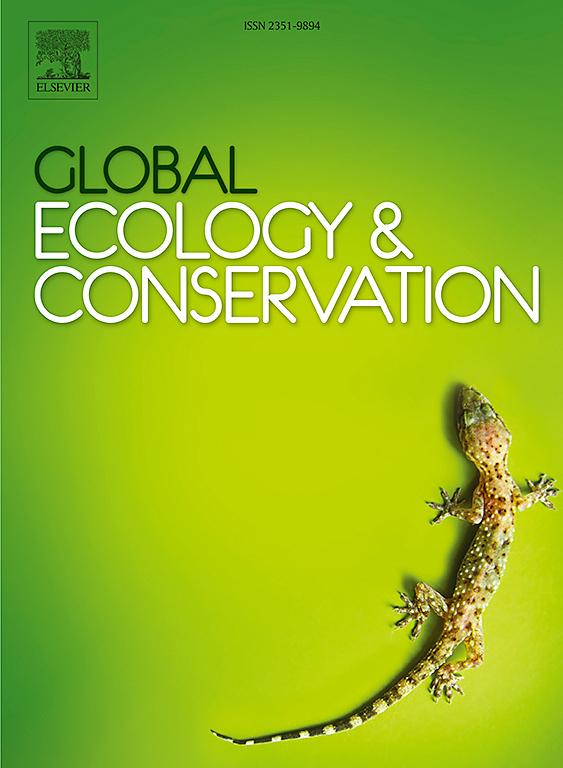印度喀拉拉邦Wayanad地区人象负面互动的时空分布
IF 3.4
2区 环境科学与生态学
Q1 BIODIVERSITY CONSERVATION
引用次数: 0
摘要
负面的人象互动(HEI)对亚洲象种群的长期保护构成了重大威胁,并对当地社区的心理健康产生了负面影响。喀拉拉邦的布拉马吉里-尼尔吉里东高止山脉是亚洲象保护的重要景观,也是亚洲象活动范围内最大的单一繁殖种群。然而,人类与大象之间的负面接触越来越频繁,已经成为一个令人担忧的突出原因。尽管如此,使用预测分布模型来绘制整个景观中人象相互作用的时空模式的探索仍然很少。我们从赔偿记录中收集了1942个个体冲突事件,动态提取了文献中确定的16个生态和人为变量,这些变量是人与亚洲象之间互动的重要驱动因素。利用包含10种算法的集成建模框架,我们构建了2011年至2023年干湿季节的预测分布模型,以绘制人象负相互作用持续风险地区的时空分布。最终共识模型的平均准确率分别为0.91 (AUC)和0.73 (TSS),并表明影响相互作用的最高预测因子是人口密度。Wayanad野生动物保护区(I和II)内和附近的地区预测相互作用的可能性最高,但风险水平因季节而异。在旱季,包括Kidanganad、Nulpuzha和Pulpalli在内的地区,在Kurichiat、Muthanga和Sulthan Battery森林范围内,被确定为面临风险的土地面积最大。相反,在雨季,Tholpetty森林范围内的Tirunelli和Trisshaleri地区表现出最高的风险。研究结果为景观层面的有效缓解战略提供了有价值的见解。本文章由计算机程序翻译,如有差异,请以英文原文为准。
Spatiotemporal distribution of negative human-elephant interactions in Wayanad district, Kerala, India
Negative human-elephant interactions (HEI) present a significant threat to the long-term conservation of Asian elephant populations and negatively impact the psychological well-being of local communities. The Brahmagiri-Nilgiri Eastern Ghats complex in Kerala is a key landscape for Asian elephant conservation and supports the largest single breeding population across their range. However, negative encounters between people and elephants are increasing in frequency and have become a prominent cause for concern. Despite this, the use of predictive distribution models to map the spatio-temporal patterns of human-elephant interactions across the landscape remains poorly explored. Compiling 1942 individual conflict incidents from compensation records, we dynamically extracted 16 ecological and anthropogenic variables identified in the literature as important drivers of interactions between people and Asian elephants. Using an ensemble modelling framework incorporating 10 algorithms, we constructed predictive distribution models for the wet and dry seasons from 2011 to 2023 to map the spatiotemporal distribution of regions at consistent risk of negative human-elephant interactions. Final consensus models achieved a mean accuracy of 0.91 (AUC) and 0.73 (TSS) respectively and suggested that the top predictor in influencing interactions is human population density. Regions within and adjacent to the Wayanad Wildlife Sanctuaries (I and II) have the highest predicted likelihood of interactions, however risk-level differs according to season. During the dry season, areas including Kidanganad, Nulpuzha, and Pulpalli, within the Kurichiat, Muthanga, and Sulthan Battery Forest ranges, were identified as having the largest land area at risk. Conversely during the wet season, the Tirunelli and Trisshaleri areas in the Tholpetty forest range demonstrated the highest risk. Results provide valuable insights to inform effective mitigation strategies at the landscape-level.
求助全文
通过发布文献求助,成功后即可免费获取论文全文。
去求助
来源期刊

Global Ecology and Conservation
Agricultural and Biological Sciences-Ecology, Evolution, Behavior and Systematics
CiteScore
8.10
自引率
5.00%
发文量
346
审稿时长
83 days
期刊介绍:
Global Ecology and Conservation is a peer-reviewed, open-access journal covering all sub-disciplines of ecological and conservation science: from theory to practice, from molecules to ecosystems, from regional to global. The fields covered include: organismal, population, community, and ecosystem ecology; physiological, evolutionary, and behavioral ecology; and conservation science.
 求助内容:
求助内容: 应助结果提醒方式:
应助结果提醒方式:


